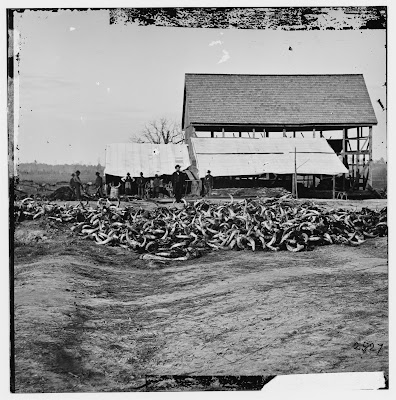As my last "Zooming In" post seems to have drawn some interest, I thought I'd share another. This one is also from the Petersburg Campaign. However, this image does not come from the City Point wharves as the last one did, rather it is from Cedar Level, Virginia, which was about three miles southwest of City Point, along the United States Military Railroad (USMRR). This supply line proved vital to the Union army and their thousands of men fighting around the Cockade City.
Students of the Petersburg Campaign are likely familiar with the several photographs showing the vast stockpiles of hardtack boxes and salt pork barrels. Most of those images were taken at Cedar Level, as was the one above, according to the Library of Congress.
The standard daily meat ration for soldiers consisted of either salt pork or fresh or pickled beef. The enlisted men preferred salted pork or fresh beef over the pickled beef. Salt did not seem to affect pork the way it did beef. The men complained that beef absorbed the salt making it virtually inedible, even when cooked thoroughly. Pork, however, did not hold in the strong salty flavor like beef did, allowing for a much better taste. Therefore, the men preferred their beef fresh. Herds of cattle were shipped from various points north by boat to City Point for the Union army's consumption.
Naturally, the animals (beef on the hoof) required processing in order to eat them. Commissary workers slaughtered, skinned, and butchered the cattle for soldier consumption. Contrabands, refugee slaves who fled to Union lines and who had significant experience with these duties from their time on plantations, often handled this less than pleasant work.
In the image above it appears that a pile of cow hides is growing to the left of photograph. It looks like the two figures on the left side are in the process of skinning one of the animals. The man on the left is African American, but the man to the right of him looks as if he is white and holding a knife of some type in his left hand. On further to the right is a barrel with a set of horns sitting on it. To the right of that a black man stands with his hands on his hips with the arms akimbo. He may have a long butcher's apron tied around his waist and over his vest. It looks like the other two men to the right of him are also African American. Behind them is what at first glace looked to be an artillery piece, but upon further inspection, looks more like a cart or wagon as the wheels appear to be too far apart for a cannon. Plus, a wagon would make much more sense in this particular setting.
In the foreground is one of the byproducts of the slaughtering process, thousands and thousands of cattle horns. While each one of the beeves provided about 500 rations for the hungry soldiers, there was not much need for the horns. I've not been able to determine what, if anything ultimately became of these objects, whether they were buried, destroyed, or used in some other fashion, If anyone happens to know, I'd be happy to hear about it.
It appears that the army re-purposed a local barn here for their use in the above close up. All of the siding has been removed, leaving a skeleton of frame beams. Perhaps the commissary wanted the cover the roof provided without the clapboards to hold in the offensive smells. Or maybe they used the clapboards for fuel or their living quarters. A canvas awning is stretched out as a type of porch covering.
A man wearing a frock coat with shoulder boards, so likely an officer, stands at the center of the image. He may be overseeing the operation or just visiting the scene on behalf of a brigade, division, or corps. He leans slightly on a cane, which is in his right hand. Under his frock coat he wears a civilian-style vest.













No comments:
Post a Comment